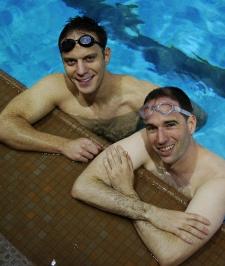“Synchronized swimming is like swimming, running a marathon and lifting weights, all while holding your breath — oh, and with a smile too.”
That’s how Andrew Delaware, founder of Breathless Synchro Toronto, describes the sport that has been his passion for the past four years. He says synchronized swimming is not only a real sport but a damn hard one.
One of only a handful of North American synchro clubs especially for gay men, Breathless is benefitting from a small but growing contingent of swimmers; men who compete for the love of their sport.
Since becoming an Olympic event in 1984 synchronized swimming has struggled to be taken seriously as an athletic pursuit. Focusing on the costumed bathing suits and heavy makeup, pop culture tended to portray women’s synchronized swimming as an aquatic fashion show rather than underwater ballet. Male synchro swimmers have it even worse, thanks to the infamous 1984 Saturday Night Live sketch featuring Martin Short and Harry Shearer.
“Martin Short should be shot,” Delaware, 34, jokes when asked about the skit. “Rather, Martin Short is welcome to come to one of our practices and learn how to swim properly.”
Delaware’s duet partner, Nathan Doidge, 33, says, like dance, synchronized swimming requires a strong sense of timing and coordination as well as all-around fitness. Though he’s been competitive water polo player for several years the well-muscled Doidge says synchro is one of the most challenging sports he’s ever been involved in.
“It’s fast-paced, demanding exercise,” he says. “It requires a lot of strength to move and boost out of the water.”
Synchro swimmers create unique performances set to music that can be funny, sad, romantic or inspiring. Like dance, making the piece look effortless is part of the act, Delaware explains.
“The trick is to make it look like you’re not working hard,” he says. “Meanwhile you feel like your lungs are going to burst.”
Doidge recalls that, as an undergraduate student at the University of Waterloo, he enjoyed the creative aspects of synchronized swimming and asked to try out for the campus team.
“My eventual answer was that synchro was only for women,” he says.
For more than 10 years he busied himself with other sports. Then in 2007 Doidge learned about the newly formed club and decided to give it a try. The team now has eight members of varying abilities who perform at recreational swim shows and competitions across North America.
It’s a common story for boys to wait until adulthood to get involved in synchro, Delaware says. Most of the male synchronized swimmers he’s met started in their 20s or 30s and spent years in other aquatic sports like competitive swimming, diving or water polo.
Contrary to popular belief, he says, many of the men are straight and perform with their female partners or spouses. While most recreational synchro teams today are open to both genders, men who defy convention still encounter a glass ceiling. The US national champion in synchronized swimming, Kenyon Smith, was barred from competing in the 2008 Olympics in Beijing. In April European news outlets reported that Niklas Stoepel, a 17-year-old German national champion in synchronized swimming, wouldn’t be allowed to compete in internationally sanctioned events.
La Fédération Internationale de Natation (FINA), the body that governs aquatic sports competitions on the world stage, continues to insist synchronized swimming is a women-only sport.
Women who have fought to compete in male-dominated spots will recognize the arguments. There aren’t enough men interested in synchronized swimming for the sport to be truly competitive. There’s not enough money floating around to fund such a small group of athletes.
“It’s sort of a chicken-and-the-egg debate,” says Delaware.
With mainstream acceptance it would be easier to recruit male synchronized swimmers to make the sport more competitive and financially viable, he insists.
Creating visibility for the sport is one of the primary goals of Breathless. Delaware and Doidge say they plan to compete at the 2009 Canadian Masters Nationals in Brantford, Ontario in June. A few weeks later they’ll board a plane for Copenhagen, Denmark to represent Toronto at the 2009 World Outgames.
Breathless coach Andrea Welsh, a 35-year veteran of synchronized swimming, says the duo is bound to make a splash at the competitions.
“There’s a pretty rigid synchro culture about what kinds of things are acceptable,” Welsh says. “Not being part of that, they’re coming at it with fresh eyes and a fresh perspective which is really fun.”
Doidge says he’s excited about the free routine; a tango duet he says will “push the envelope.” Otherwise, he’s not really worried about medals or sponsorship deals.
“I’d rather help establish Breathless as a team for anyone who wants to try synchronized swimming and one that’s going to be around for a long time,” he says.

 Why you can trust Xtra
Why you can trust Xtra


